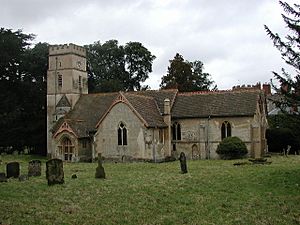All Saints Church, Shirburn facts for kids
Quick facts for kids All Saints' Church, Shirburn |
|
|---|---|

All Saints' Church, Shirburn, from the south
|
|
| Lua error in Module:Location_map at line 420: attempt to index field 'wikibase' (a nil value). | |
| OS grid reference | SU 696 959 |
| Location | Shirburn, Oxfordshire |
| Country | England |
| Denomination | Anglican |
| Website | Churches Conservation Trust |
| Architecture | |
| Functional status | Redundant |
| Heritage designation | Grade II |
| Designated | 18 July 1963 |
| Architect(s) | T. H. Wyatt (1876 restoration) |
| Architectural type | Church |
| Style | Norman, Gothic, Georgian, Gothic Revival |
| Completed | 1876 |
| Specifications | |
| Materials | Rendered chalk and flint Brick north transept Tiled roofs |
All Saints' Church is an old church in Shirburn, Oxfordshire, England. It used to be a regular church for the local community. Now, it is looked after by the Churches Conservation Trust. This trust helps to protect important old churches.
The church is a special building, listed as Grade II. This means it is an important historical place that needs to be preserved. You can find the church at the west end of Shirburn village. It is very close to Shirburn Castle, which has been the home of the Earls of Macclesfield family for a long time. A part of the church, the north chapel, is a special burial place for the Parker family, who are the Earls of Macclesfield.
History of All Saints' Church
The church was first built a very long time ago, around the late 1000s or early 1100s. Over the years, new parts were added and changes were made. This happened in the 1200s and 1300s.
More changes were made in the 1700s. At that time, the top part of the church tower was added. In the early 1800s, a new section called a north transept was built. This was a private seating area for the Earl of Macclesfield's family.
In 1876, the church had a big "restoration." This means it was repaired and largely rebuilt by an architect named T. H. Wyatt. Many old churches were restored during the Victorian era to keep them strong. In 1995, the church was no longer used for regular services. It was then given to the Churches Conservation Trust to be cared for.
You might have even seen this church on TV! In 2011, it was used as a filming location for the popular detective show Midsomer Murders.
Architecture and Design
Most of All Saints' Church is built from chalk and flint stones. These stones are covered with a smooth plaster-like material called stucco. The north transept, which was added later, is made of brick. All the roofs on the church are covered with tiles.
The church has a special shape called a cruciform plan. This means it looks like a cross from above. It has a main area called the nave, with side sections called aisles. There are also north and south transepts, which are the "arms" of the cross shape. The church also has a south porch, a chancel (the area near the altar), and a small room called a vestry. At the west end, there is a tall tower.
Next to the tower, on the south side, there is a circular staircase built in the 1800s. On the north side of the tower, you can see a window with two parts. This window is likely from the Norman period, which was very early in the church's history. The very top part of the tower was added in the Georgian style, which was popular in the 1700s.
Above an old medieval window in the tower, there is a special stone carving called a tympanum. It has a cool figure-of-eight pattern. Inside the tower, there's another special stone piece called a lintel. This one is decorated with stars, animal heads, and plants. These old carvings were put in these spots during the 1876 restoration. The windows around the church show different styles from the 1100s all the way to the 1800s.
Inside the church, you'll find two sets of arcades from the 1200s. These are rows of arches that separate the nave from the aisles. There's also an arcade between the chancel and the north chapel. You can see special plaques and monuments inside the church. These are memorials to important families like the Chamberlain and Macclesfield families.
In the south transept, there is a piscina from the 1300s. This was a small basin used for washing sacred vessels. In the nave, there is a font from the 1200s. This is a large bowl used for baptisms. It has a cover from the 1700s. The beautiful stained glass in the east window was made by a company called Ward and Hughes. The church also has an organ, which was built in the 1880s by Gray and Davison.
See also

